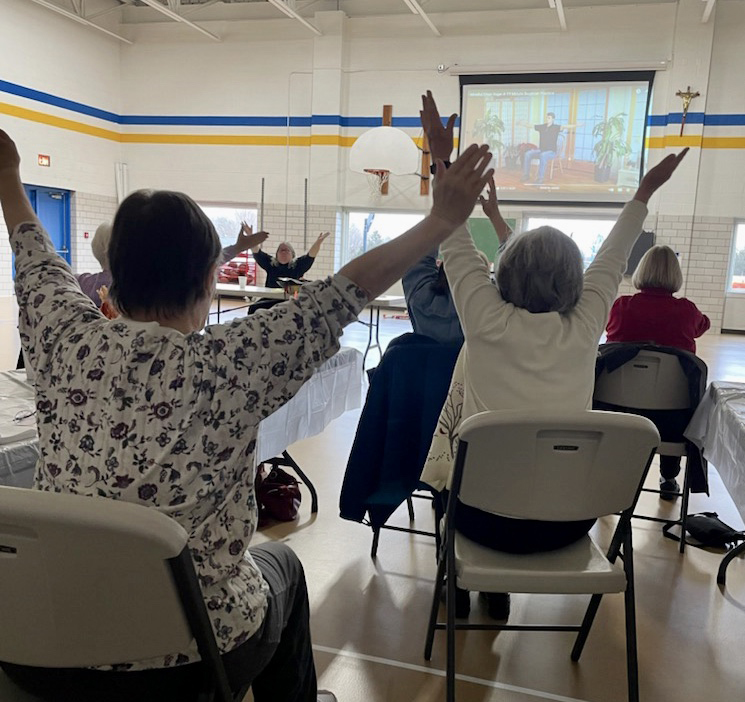
Patrice Taft, a mental health consultant, leads women at a pre-Advent retreat through a sitting exercise that included mindful breathing and stretching – a tool that can be used during a work break, before personal prayer or in an overwhelming moment to calm and center oneself. (Submitted photo)
Jenny Snarski
Catholic Herald Staff
“Peace and anxiety are both contagious,” declared Patrice Taft at the conclusion of the pre-Advent mindfulness retreat hosted by the CCW’s Southwest Deanery on Nov. 13 at St. Anne Catholic School in Somerset.
“Please, choose peace,” she implored. A therapist turned mental health consultant, she made the request having spent the previous two hours instructing, guiding exercises and reflecting with the 25 women in attendance.
Taft began the morning by playing a music video for Christian music artist Peter Mayer’s song “Japanese Bowl.” The lyrics speak about the Japanese practice of kintsugi.
Kintsugi is the practice of repairing cracks and aging in pottery with gold filler. Rather than hiding the imperfections, the art form accentuates them and makes the piece more valuable in the process.
“Now every old scar shows from every time I broke, and anyone’s eyes can see I’m not what I used to be,” the song says. “But in a collector’s mind, all of these jagged lines make me more beautiful and worth a higher price.”
“We all have cracks – are we going to fill them with gold?” Taft asked when the video ended.
She went on to describe the integration and wholeness God wants and invites us to, but that it often isn’t accessible by giving in to the voices of shame that drown out the divine invitation.
“We are living through gold-cracking times,” Taft said, referring to the pandemic dragging on for almost two years.
Acknowledging the stress of it all, she clarified that there are two primary types of stress. The first is intense stress, which is related to a tragic event or loss; the second is prolonged stress, which wears and breaks a person down over time.
It is the prolonged stress Taft said disintegrates the most, especially when it relates to circumstances out of one’s control. Often a person’s way of dealing with it is through distraction and disconnection.
Her primary goal was to give the women basic mindfulness tools. Her method was interactive and experiential so that stresses, difficult circumstances and overwhelming busyness can be handled in different ways.
“What you resist persists,” Taft confirmed. “What we let in, we can deal with.”
Throughout the presentation, Taft had the women learning new ways of observing and directing their attention, of relaxing their bodies and tuning into their physical and spiritual senses.
Mindfulness was defined as “curious and non-judgmental attention to the present moment.”
Taft said the goal of relaxing and centering oneself during a mindfulness practice needs to be set aside – simply to be open and curious about one’s experience – taking a step towards it, listening to the body and becoming familiar with reactions and responses to internal and external dynamics.
Pausing to tune in with and through the body provides a way to connect with the present moment – the place where God is waiting to have an encounter.
The speaker addressed the overload of sensory stimulation in modern environments and the autopilot mode in which many operate, rarely activating their ability to make decisions and choose their actions.
In one of the exercises, the women were invited to extend their attention to a sensitive or uncomfortable area of their lives. Participants were guided to focus on that, then move their attention to something concrete in their immediate surroundings and describe it in detail. They were told to then move their focus back to the original subject and see what interior differences they noticed throughout the process.
A “gratefulness walk” was the final exercise Taft led. This consisted of saying out loud – in a whispered voice, given the proximity of participants – an affirmation of gratitude followed by a conscious step, then another and another.
Taft recapped the exercise using one woman’s comments: “Stop. Be grateful. Move on.”
To conclude, she taught a breath prayer. It is a type of short, spontaneous prayer that brings one’s awareness to God’s presence with every breath and can be done anywhere.
She gave examples: “Holy God, be my light”; “Lord, I want your will”; and “My trust is in you.” The breath is inhaled with the first phrase and exhaled with the second.
As the speaker offered the comparison of peace and anxiety as both contagious, she added, “Most of the things we worry about never happen – proof that worry doesn’t work.” With humor and storytelling woven throughout the retreat, Taft made clear that what she presented was merely scratching the surface of tools and techniques that can integrate the mind, body and soul.
When the priest scheduled to celebrate Mass was unable to attend, the group prayed the luminous mysteries of the rosary together in the church. Organizer Bridgette Adler shared, “It felt really moving to pray together” after the shared learning and exercises.
Adler added that she received very positive feedback from those in attendance.
Personally, Adler appreciated Taft’s teaching of easy exercises that can be practiced at home. She noted also that others appreciated the gratitude walk in particular.
In the highly consumerist atmosphere that says “we should be ‘all in’ on Christmas even before Thanksgiving,” Adler affirmed, “there is such fruitfulness in mindfully embracing the season of Advent.”
